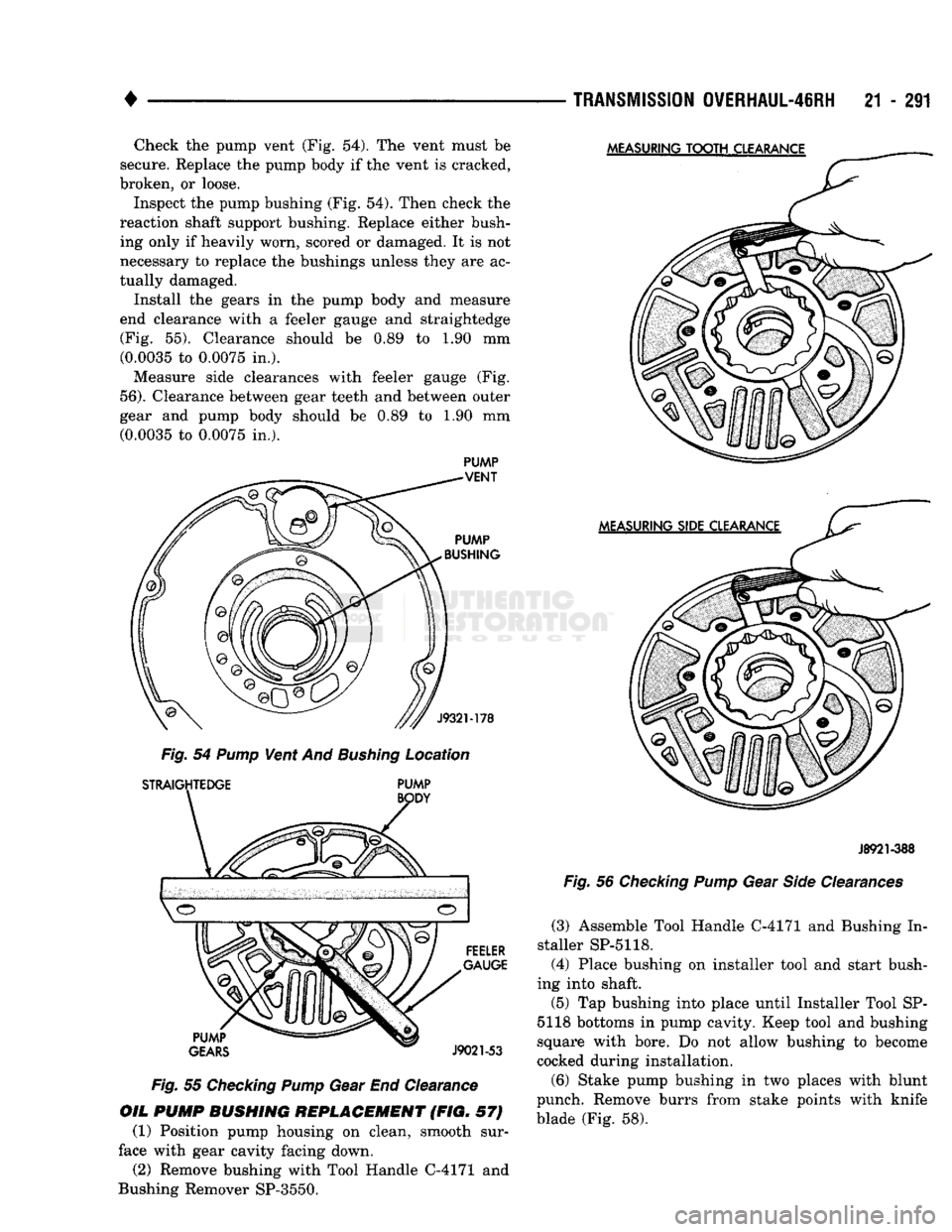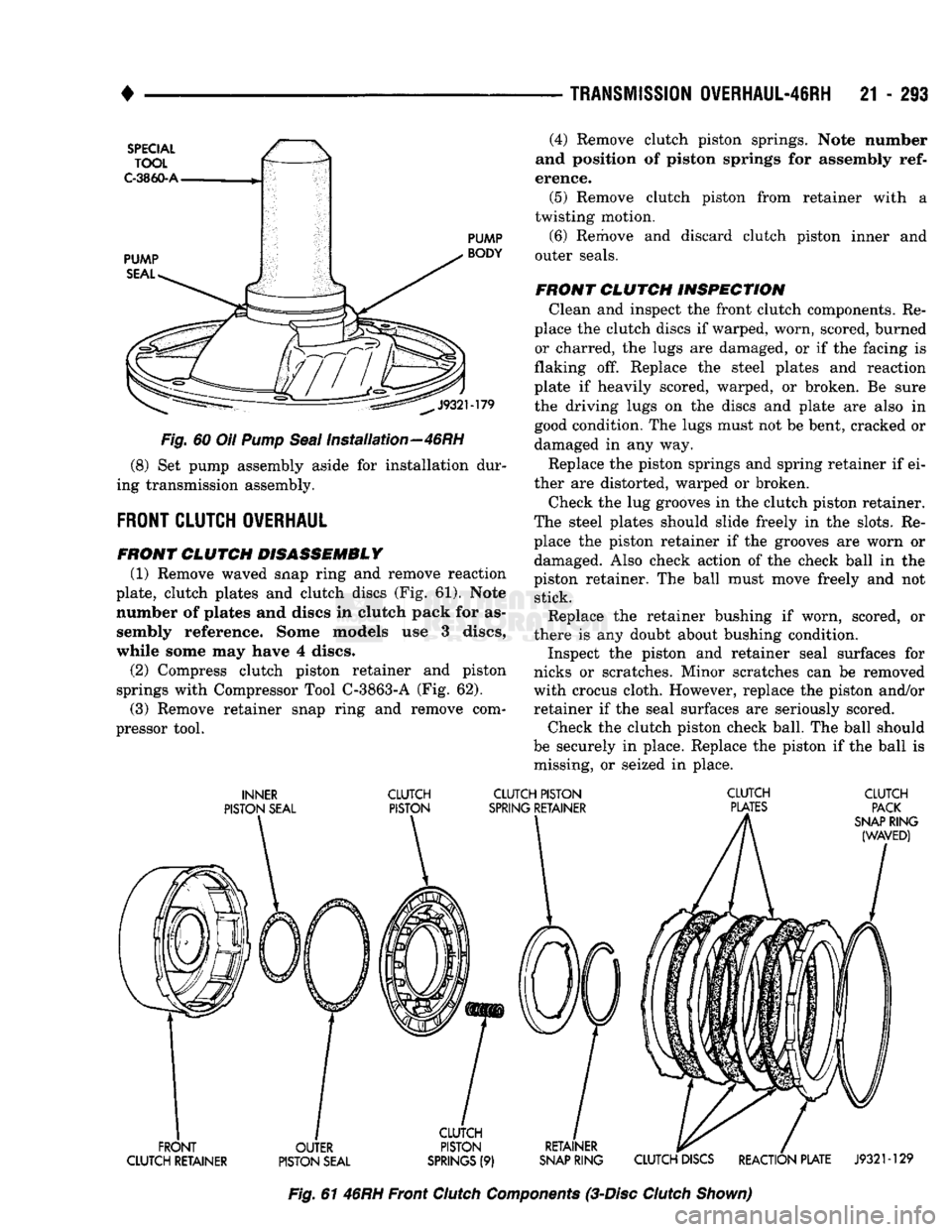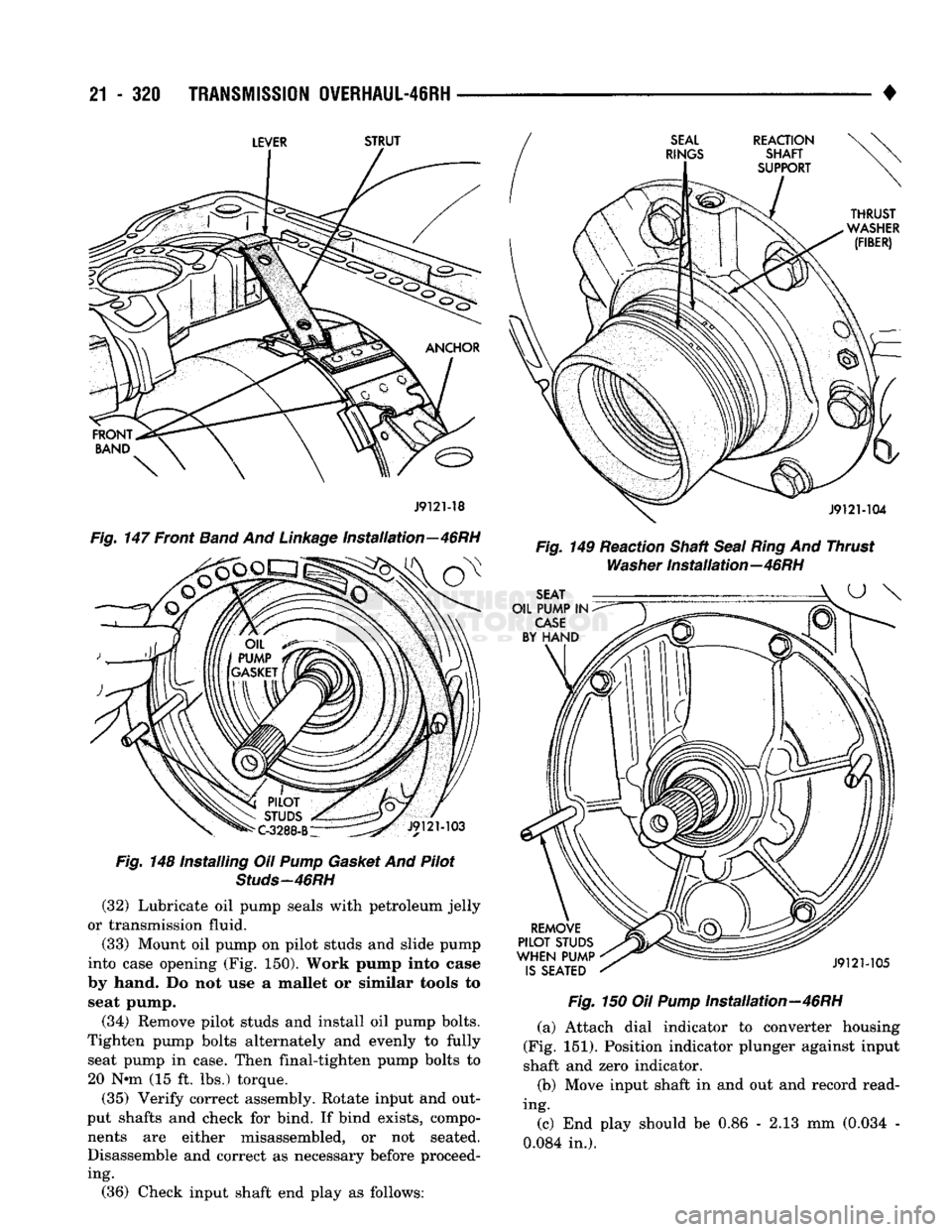1993 DODGE TRUCK transmission oil
[x] Cancel search: transmission oilPage 1292 of 1502

+
Fig.
55
Checking
Pump
Gear End Clearance
OIL
PUMP
BUSHING
REPLACEMENT
(FIG. 57} (1) Position pump housing on clean, smooth sur
face with gear cavity facing down.
(2) Remove bushing with Tool Handle C-4171 and
Bushing Remover SP-3550.
TRANSMISSION
0VERHAUL-46RH
21 - 291
J8921-388
Fig.
56
Checking
Pump
Gear
Side
Clearances
(3) Assemble Tool Handle C-4171 and Bushing In
staller SP-5118. (4) Place bushing on installer tool and start bush
ing into shaft.
(5) Tap bushing into place until Installer Tool SP-
5118 bottoms in pump cavity. Keep tool and bushing
square with bore. Do not allow bushing to become
cocked during installation.
(6) Stake pump bushing in two places with blunt
punch. Remove burrs from stake points with knife
blade (Fig. 58).
Check the pump vent (Fig. 54). The vent must be
secure. Replace the pump body if the vent is cracked,
broken, or loose.
Inspect the pump bushing (Fig. 54). Then check the
reaction shaft support bushing. Replace either bush ing only if heavily worn, scored or damaged. It is not
necessary to replace the bushings unless they are ac
tually damaged.
Install the gears in the pump body and measure
end clearance with a feeler gauge and straightedge (Fig. 55). Clearance should be 0.89 to 1.90 mm (0.0035 to 0.0075 in.).
Measure side clearances with feeler gauge (Fig.
56).
Clearance between gear teeth and between outer
gear and pump body should be 0.89 to 1.90 mm (0.0035 to 0.0075 in.).
PUMP
Page 1293 of 1502

21
- 292
TRANSMISSION
OVERHAUL-46RH
•
SPECIAL
TOOL
C-4171
BUSHING
REMOVAL
PUMP HOUSING
SPECIAL
TOOL
C-4171
SPECIAL
TOOL
SP-3550
BUSHING
SPECIAL
TOOL
SP-5118
J9221-244
Fig. 57 Replacing Oil Pump Bushing
mm
Fig. 58 Staking-Debum'ng Oil Pump Bushing
REPLACING
REACTION SHAFT SUPPORT
BUSHING
(FIG. 59)
(1) Assemble Cup Tool SP-3633, Nut SP-1191 and
Bushing Remover
SP-5301.
(2) Hold cup tool firmly against reaction shaft.
Thread remover tool into bushing as far as possible
by hand.
(3) Using wrench, thread remover tool an addi
tional 3-4 turns into bushing to firmly engage tool.
(4) Tighten tool hex nut against cup tool to pull
bushing from shaft. Clean all chips from shaft and support after bushing removal.
(5) Place reaction shaft support upright on a clean,
smooth surface.
(6) Assemble Bushing Installer Tools C-4171 and
SP-5302. Then slide new bushing onto installer tool. (7) Start bushing in shaft. Tap bushing into shaft
until installer tool bottoms against support flange. (8) Clean reaction shaft support thoroughly after
bushing replacement (to remove any chips).
SPECIAL
TOOL
SP-1191
SPECIAL
TOOL
C-4171
SPECIAL
TOOL
SP-5302
BUSHING BUSHING
X
REACTION SHAFT
BUSHING
REMOVAL BUSHING
INSTALLATION
J9221-245
Fig. 59 Reaction Shaft Bushing Replacement—46RH
ASSEMBLING
OIL
PUMP
AND
REACTION SHAFT SUPPORT
(1) Lubricate pump gears with transmission fluid
and install them in pump body.
(2) Install thrust washer on reaction shaft support
hub.
Lubricate washer with petroleum jelly or trans mission fluid before installation.
(3) If reaction shaft seal rings are being replaced,
install new seal rings on support hub. Lubricate seal
rings with transmission fluid or petroleum jelly after installation. Squeeze each ring until ring ends are
securely hooked together.
CAUTION:
The
reaction shaft support seal
rings
will
break
if
overspread,
or
twisted.
If new
rings
are be
ing
installed,
spread them only enough
for
installa
tion.
Also
be
very sure
the
ring ends
are
securely
hooked
together
after
installation. Otherwise,
the
rings
will
either
prevent
pump
installation,
or break
during installation.
(4) Align and install reaction shaft support on
pump body.
(5)
Install bolts attaching reaction shaft support to
pump. Tighten bolts to 20 N»m (175 in. lbs.) torque. (6) Install new pump seal with Seal Installer
C-3860-A (Fig. 60). Use hammer or mallet to tap seal
into place.
(7) Install new O-ring on pump body. Lubricate oil
seal and O-ring with petroleum jelly.
Page 1294 of 1502

TRANSMISSION
0VERHAUL-46RH
21 - 293
(4) Remove clutch piston springs. Note number
and position of piston springs for assembly
ref
erence. (5) Remove clutch piston from retainer with a
twisting motion. (6) Remove and discard clutch piston inner and
outer seals.
FRONT CLUTCH INSPECTION
Clean and inspect the front clutch components. Re
place the clutch discs if warped, worn, scored, burned or charred, the lugs are damaged, or if the facing is
flaking off. Replace the steel plates and reaction
plate if heavily scored, warped, or broken. Be sure
the driving lugs on the discs and plate are also in
good condition. The lugs must not be bent, cracked or
damaged in any way.
Replace the piston springs and spring retainer if ei
ther are distorted, warped or broken.
Check the lug grooves in the clutch piston retainer.
The steel plates should slide freely in the slots. Re
place the piston retainer if the grooves are worn or damaged. Also check action of the check ball in the
piston retainer. The ball must move freely and not stick.
Replace the retainer bushing if worn, scored, or
there is any doubt about bushing condition. Inspect the piston and retainer seal surfaces for
nicks or scratches. Minor scratches can be removed
with crocus cloth. However, replace the piston and/or
retainer if the seal surfaces are seriously scored. Check the clutch piston check ball. The ball should
be securely in place. Replace the piston if the ball is missing, or seized in place.
INNER
CLUTCH CLUTCH PISTON CLUTCH CLUTCH
Fig.
61
46RH
Front
Clutch
Components
(3-Disc
Clutch
Shown)
SPECIAL
TOOL
C-3860-A
PUMP
SEAL
PUMP
BODY
J932M79
Fig.
60 Oil
Pump Seal
Installation—46RH (8) Set pump assembly aside for installation dur
ing transmission assembly.
FRONT
CLUTCH
OVERHAUL
FRONT CLUTCH
DISASSEMBLY
(1) Remove waved snap ring and remove reaction
plate, clutch plates and clutch discs (Fig. 61). Note
number of plates and discs in clutch pack for as sembly reference. Some models use 3 discs,
while some may have 4 discs.
(2) Compress clutch piston retainer and piston
springs with Compressor Tool C-3863-A (Fig. 62).
(3) Remove retainer snap ring and remove com
pressor tool.
Page 1299 of 1502

21
- 298
TRANSMISSION
0¥IRHAUL-48RH
•
Fig.
72 Driving Shell Thrust Washer Removal—46RH
INTERMEDIATE SHAFT
Fig.
73 Sun Gear And Driving Shell Assembly
Removal—46RH
SUN
REAR
SHELL
J932M72
Fig.
74 Rear Planetary Thrust
Washer
Removal—46RH
Inspect the machined surfaces of the intermediate
shaft. Be sure the oil passages are open and clear.
Replace the shaft if scored, pitted, or damaged.
INTERMEDIATE REAR REAR
SHAFT ANNULUS PLANETARY
J932M73
Fig.
75 Rear Planetary And Annulus Gear Removal—46RH
REAR
J9321-174
Fig.
76 Rear Annulus Thrust Plate Removal—46RH
Inspect the sun gear and driving shell (Fig. 77). If
either component is worn or damaged, remove the sun gear rear retaining ring and separate the sun
gear and thrust plate from the driving shell. Then
replace the necessary component.
Replace the sun gear as an assembly if the gear
teeth are chipped or worn. Also replace the gear as an assembly if the bushings are scored or worn. The
sun gear bushings are not serviceable. Replace the
thrust plate if worn, or severely scored. Replace the driving shell if distorted, cracked, or damaged in any
way.
PLANETARY GEARTRAIN ASSEMBLY AND
ADJUSTMENT
(1) Lubricate sun gear and planetary gears with
transmission fluid during assembly. Use petroleum
jelly to lubricate output shaft bushing surfaces, thrust washers and thrust plates.
(2)
Install front snap ring on sun gear and install
gear in driving shell. Then install thrust plate over sun gear and against rear side of driving shell (Fig.
Page 1310 of 1502

TRANSMISSION
0VERHAUL-4IRH
21 - 309
LOWER HOUSING
3-4
SHUTTLE
3-4
ACCUMULATOR PISTON
3-4
ACCUMULATOR HOUSING
3-4
SHUTTLE VALVE
THROTTLE PLUG
TIMING VALVE
COVER
3-4 SHIFT
VALVE AND
SPRING
SPRING
RETAINER
CONVERTER CLUTCH TIMING VALVE AND SPRING
CONVERTER CLUTCH
SOLENOID SOLENOID
GASKET
OVERDRIVE
SEPARATOR
PLATE
J932M58
3^4 ACCUMULATOR
HOUSING
ACCUMULATOR PISTON
Fig.
116 Shift Valves
And
Springs—46RH
Lower
Housing
CAUTION: Many
of the
valves
and
plugs, such
as
the
throttle
valve,
shuttle
valve
plug,
1-2
shift
valve
and
1-2
governor
plug,
are
made
of
coated
alumi
num
(Fig.
118).
Aluminum
components
are
identi
fied
by the
dark
color
of the
special
coating
applied
to
the
surface
(or by
testing
with
a
magnet).
Do not
polish
or
sand
aluminum
valves
or
plugs
with
any
type
of
material.
This
practice
could
damage
the
special
coating
and
cause
the
valves
and
plugs
to
stick
and
bind. PISTON
SEAL
RING
PISTON
SPRING
END
PLATE
J9121-277
Fig.
117 3-4
Accumulator
Housing
Components—46RH
Inspect
the
valves
and
plugs
for
scratches, burrs,
nicks,
or
scores. Minor surface scratches
on
steel
valves
or
plugs
can be
removed with crocus cloth
but
do
not
round
off the
edges
of the
valve
or
plug
lands.
Maintaining sharpness
of
these edges
is vi
tally important.
The
edges prevent foreign matter from lodging between
the
valves
and
plugs
and the
bore.
Inspect
all the
valve
and
plug bores
in the
valve
body.
Use a
penlight
to
view
the
bore interiors.
Re
place
the
valve body
if any
bores
are
distorted
or
scored. Inspect
all of the
valve body springs.
The
springs must
be
free
of
distortion, warpage
or
broken
coils.
Check
the two
separator plates
for
distortion
or
damage
of any
kind. Inspect
the
upper housing,
lower housing,
3-4
accumulator housing,
and
transfer
face.
If
distortion
is
severe
or any
surfaces
are
heavily scored,
the
valve body will have
to be re
placed.
Page 1316 of 1502

•
TRANSMISSION
OVERHAUL-46RH
21 - 315
The kickdown valve spring must be fully com
pressed and the kickdown valve completely bot
tomed to obtain correct adjustment.
Fig.
128
Throttle
Pressure
Adjustment
TRANSMISSION ASSEMBLY
Assembly
Tips
Do not allow dirt, grease, or foreign material to en
ter the case or transmission components during as sembly. Keep the transmission case and components
clean. Also make sure the tools and workbench area
used for reassembly operations are equally clean.
Shop towels used for wiping off tools and your
hands must be made from lint free materials. Lint
will stick to transmission parts and could interfere
with valve operation or even restrict fluid passages.
Lubricate transmission clutch and gear components
with Mopar ATF Plus or Dexron II™ during reassem
bly. Soak clutch discs in transmission fluid before in stallation.
Use Ru-Glyde, Door-Eze, or petroleum jelly on
seals and O-rings to ease installation. Petroleum
jelly can also be used to hold thrust washers and plates in position during assembly operations. However, do not use chassis grease, bearing grease,
white grease, or similar lubricants on any part.
These types of lubricants can eventually block or re strict fluid passages and valve operation. Use petro
leum jelly only.
Do not force parts into place. The transmission
components and sub-assemblies are easily installed
by hand when properly aligned. If a part seems diffi cult to install, it is either misaligned or incorrectly
assembled. Verify that thrust washers, thrust plates
and seal rings are correctly positioned. These parts
will prevent proper assembly is mispositioned (or "left out" by accident).
The planetary geartrain, front/rear clutch assem
blies and oil pump are all much easier to install
when the transmission case is upright or as close to
this position as possible. Either tilt the case upward with wood blocks, or cut a hole in the bench large
enough for the output shaft and rear support. Then
lower the shaft and support into the hole and support
the rear of the case directly on the bench.
TRANSMISSION ASSEMBLY PROCEDURE
(1) Lubricate rear servo piston seal with petroleum
jelly, or Door Eze. Lubricate servo bore in case with transmission fluid.
(2) Install rear servo piston in case. Position piston
at slight angle to bore and insert piston with twist
ing motion (Fig. 129).
Fig.
129 Installing Rear
Servo
Piston—46RH
(3) Install rear servo spring and retainer in case
bore (Fig. 130). Be sure spring is seated on piston.
Fig.
130 Installing Rear
Servo
Piston
Spring
And Retainer—46RH (4) Compress rear servo piston with C-clamp or
Valve Spring Compressor C-3422-B and install servo
piston snap ring (Fig. 131).
(5) Install new gasket at rear of transmission case.
Use petroleum jelly to hold gasket in place. Be sure
to align governor feed holes in gasket with feed passages in case (Fig. 132). Install gasket before
Page 1320 of 1502

•
TRANSMISSION
0VERHAUL-46RH
21 - 319
Fig. 143 input Shaft Seat Ring And Thrust Washer Installation—46RH
Fig. 144 Assembling Front And Rear Clutches-46RH (28) Tighten front band adjusting screw until band
is tight on clutch retainer. Verify that front/rear
clutch assembly is still properly seated before tight
ening band.
(29) Install oil pump Pilot Studs
C-3288-B
in case
(Fig. 148). Fig. 145 Installing intermediate Shaft Thrust
Washer-46RH
Fig. 146 Installing Front/Rear Clutch Assemblies—46RH (30) Install new oil pump gasket on pilot studs and
seat it in case. Be sure gasket is properly aligned
with fluid passages in case (Fig. 148). (31) Check seal rings on reaction shaft support. Be
sure rings are hooked together correctly. Also be sure
fiber thrust washer is in position (Fig. 149). Use pe
troleum jelly to hold washer in place if necessary.
Page 1321 of 1502

21
- 320
TRANSMISSION
0¥ERHAUL-46RH
LEVER
STRUT
J9121-18
Fig.
147 Front
Band
And
Linkage
Installation—46RH
Fig.
148 Installing Oil
Pump
Gasket
And Pilot
Studs-46RH
(32) Lubricate oil pump seals with petroleum jelly
or transmission fluid.
(33) Mount oil pump on pilot studs and slide pump
into case opening (Fig. 150). Work pump into case
by hand. Do not use a mallet or similar tools to seat pump.
(34) Remove pilot studs and install oil pump bolts.
Tighten pump bolts alternately and evenly to fully seat pump in case. Then final-tighten pump bolts to 20 N-m (15 ft. lbs.) torque.
(35) Verify correct assembly. Rotate input and out
put shafts and check for bind. If bind exists, compo nents are either misassembled, or not seated.
Disassemble and correct as necessary before proceeding. •
Fig.
149 Reaction Shaft
Seal Ring
And Thrust
Washer
installation—46RH
Fig.
150 Oil
Pump
installation—46RH (a) Attach dial indicator to converter housing
(Fig. 151). Position indicator plunger against input
shaft and zero indicator.
(b) Move input shaft in and out and record read
ing.
(c) End play should be 0.86 - 2.13 mm (0.034 -
0.084 in.). (36) Check input shaft end play as follows: